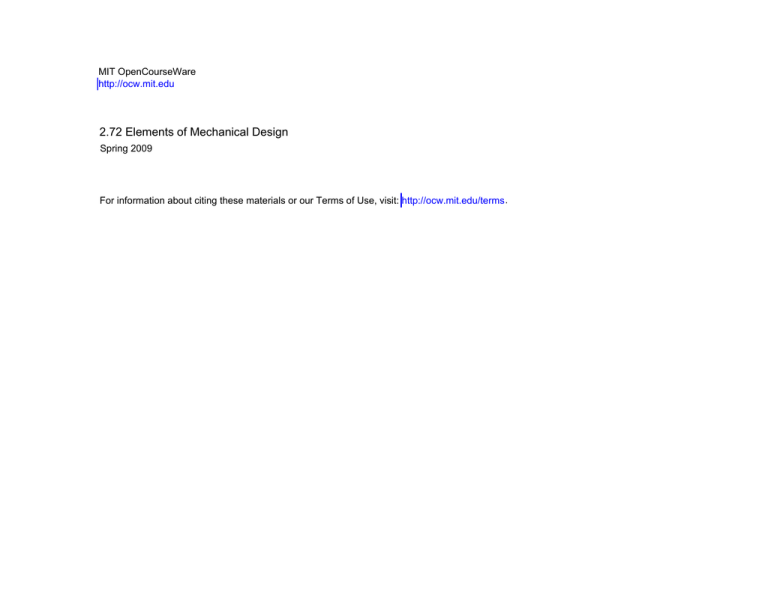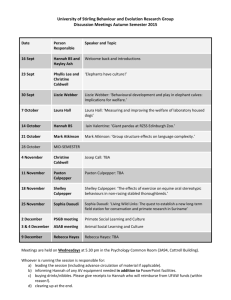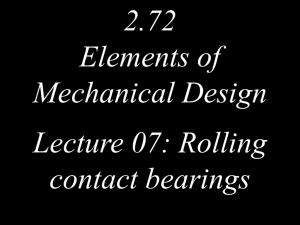
MIT OpenCourseWare
http://ocw.mit.edu
2.72 Elements of Mechanical Design
Spring 2009
For information about citing these materials or our Terms of Use, visit: http://ocw.mit.edu/terms.
2.72
Elements of Mechanical Design
Lecture 03: Shafts
Schedule and reading assignment
Reading quiz
Hand forward lathe exercise quiz
Topics
Finish matrices, errors
Shaft displacements
Stiffness exercise
Reading assignment
Shigley/Mischke
• Sections 6.1–6.4: 10ish pages & Sections 6.7–6.12: 21ish pages
• Pay special attention to example 6.12 (modified Goodman portion)
© Martin Culpepper, All rights reserved
2
Deflection within springs and shafts
Shafts, axles and rails
Shafts
Rotating, supported by bearings/bushings
Dynamic/fluctuating analysis
Axles
Non-rotating, supported by bearings/bushings
Static analysis
Rails
Non-rotating, supports bearings/bushings
Static analysis
© Martin Culpepper, All rights reserved
4
Examples drawn from your lathe
© Martin Culpepper, All rights reserved
5
Examples drawn from your lathe
© Martin Culpepper, All rights reserved
6
In practice, we are concerned with
Deflection
Stiffness
Bearings and stiffness of connectivity points
Function of global shaft geometry, sometimes adjacent components
Stress
Catastrophic failure:
Ductile
Function of local shaft geometry
© Martin Culpepper, All rights reserved
Brittle
Fatigue
7
What is of concern?
Deflection and stiffness
Beam bending models
Superposition
Load and stress analysis
Bending, shear & principle stresses
Endurance limit
Fatigue strength
Endurance modifiers
Stress concentration
Fluctuating stresses
Failure theories
Von Mises stress
Maximum shear stress
© Martin Culpepper, All rights reserved
8
Materials
Steel vs. other materials
Aluminum
Brass
Cast iron
Important properties
Modulus
Yield stress
Is density important?
Fatigue life
CTE
Material treatment – Hardening
What does hardening do the material properties
It is expensive
Affects final dimensions
You can usually design without this
© Martin Culpepper, All rights reserved
9
Principles of stiffness: Relationships
q
q d4y
= 4
EI dx
V
d3y
= 3
EI dx
M d2y
= 2
EI dx
θ=
dy
dx
© Martin Culpepper, All rights reserved
q
V
M
θ
10
Modeling: General forms of equations
Lateral bending deflection (middle)
F
F L3
F L3
Const
δ=
48E I
EI
Axial deflection
RL
RR
F L
δ=
AE
Lateral bending angles (at ends)
F L2
F L2
ML
δ=
=
or
6 E I Const E I
Const E I
© Martin Culpepper, All rights reserved
11
Modeling: Stiffness
Lateral bending stiffness at middle
kb
(
E I)
= 48
= Const (E I ) Ln
F
L3
Axial stiffness
RL
RR
AE
kA =
L
Torsional stiffness
Stepped shafts?
J G
kθ =
L
© Martin Culpepper, All rights reserved
12
Modeling: Stiffness
These pop up in many places, memorize them
Square cross section
1 3
I = bh
12
Circular cross sections
I=
[
(d
64
J=
[
(d
32
© Martin Culpepper, All rights reserved
π
4
4
)
(
)
−
d
outer
inner ]
π
)
4
outer
− (d inner )
4
]
13
Principles of stiffness: Ratios
Everything deforms
Impractical to model the stiffness of everything
Mechanical devices modeled as high, medium & low stiffness elements
Stiffness ratios show what to model as high-, medium, or low stiffness
k1st
Rk =
k2nd
Stiffness ratio
½l
F
F
kaxial
AE
=
l
klateral
3EI
= 3
l
AE
2
l
Rk = l = 4 2
3EI
h
l3
Building intuition for stiffness
You can’t memorize/calculate everything
Engineers must be reasonable “instruments”
Car suspension is easy, but flexed muscle vs. bone?
© Martin Culpepper, All rights reserved
14
Principles of stiffness: Sensitivity
Cantilever
L
F
F ⋅ L3
δ=
3⋅ E ⋅ I
1
I = ⋅b ⋅ h 3
12
⎛ E ⋅b ⎡ h ⎤ 3 ⎞
⋅ ⎢ ⎥ ⎟ ⋅δ
F =⎜
⎜ 4 ⎣L⎦ ⎟
⎝
⎠
© Martin Culpepper, All rights reserved
h
b
δ
1
Lm
hn
3
3
⎫
⎧
dF
d ⎪ E ⋅b ⎡ h ⎤
E ⋅b ⎡ h ⎤
⎪
→
⋅⎢ ⎥
δ
k=
=
⋅
⋅
⎬
⎨
⎢
⎥
4 ⎣L⎦
dδ dδ ⎪⎩ 4 ⎣ L ⎦
⎪⎭
15
Superposition
You must be careful, following assumptions are needed
Cause and effect are linearly related
No coupling between loads, they are independent
Geometry of beam does not change too much during loading
Orientation of loads does not change too much during loading
Use your head, when M = 0, what is going on
Superposition is not plug and chug
You must visualize
You must think
© Martin Culpepper, All rights reserved
16
Types of springs and behaviors
Springs and stiffness
kF = dF(x)/dx
Force-Displacement Curve
F(x)=F
Constant force spring
= dF(x)/dx = 0
kF
ΔEb-a = F • (xb - xa )
F
a
Constant stiffness spring
F
kF
= Constant
ΔEb-a = 0.5 • kF • (xb2 - xa2 )
Force-Displacement Curve
F
F
b
x
F(x)=kF•x
F
1
kF
a
x
b
a
x
b
Non-linear force spring
kF
= function of x
ΔEb-a = ∫ F(x) • dx
© Martin Culpepper, All rights reserved
Force-Displacement Curve
F
Images from Wikimedia Commons, http://commons.wikimedia.org
17
Non-conformal contact – ball on flat
Non-conformal contacts often non-linear
Example: bearings, belleville washers, structural connections
Is anything ever perfectly conformal?
Specific case: Hertzian contact
F
80
k [N/micron]
In-plane stiffness
60
40
20
0
0
250
500
750
1000
Preload [N]
⎛ 13 2 3 ⎞ 13
kn (F ) = Constant ⋅ ⎜ R ⋅ E ⎟ ⋅ F
⎝
⎠
© Martin Culpepper, All rights reserved
18
Linearization of non-linear springs
If you can linearize over the appropriate range… then
you can use superposition
So how would, and when could, you do this?
R = ball radius
E = modulus of both materials (both steel)
F = contact load
dF
⎛ 13 2 3 ⎞ 13
= kn (F ) = Constant ⋅ ⎜ R ⋅ E ⎟ ⋅ F
dδ
⎝
⎠
© Martin Culpepper, All rights reserved
19
Practical application to the lathe problem
y
© Martin Culpepper, All rights reserved
x
F
Case 11 in Appendix A-9
20
Practical application to the lathe problem
y
F
x
y ( x ) A→B
1
2
=
⋅ F ⋅ x (11x − 9l )
96EI
( )
y l
1
7 3
=
⋅F ⋅ l
2 96 EI
8
k Beam
768 E I
=
⋅ 3
7
l
But, is this really what is going on?
© Martin Culpepper, All rights reserved
21
Practical application to the lathe problem
y
F
x
k Beam
y
Vs. ?
x
½k
© Martin Culpepper, All rights reserved
768 E I
=
⋅ 3
7
l
F
½k
22
Practical application to the lathe problem
y
x
½k
© Martin Culpepper, All rights reserved
F
½k
23
Practical application to the lathe problem
Or is it this?
If so, does it matter?
y
x
½k
© Martin Culpepper, All rights reserved
F
kbearing
½k
24
Practical application to the lathe problem
δ1
δ2
x
F
δ1
½F
½F
½F
© Martin Culpepper, All rights reserved
½F
δ2
½k
δ2
½k
25
Group work
Obtain an equation for δtotal in terms of F, k and l
Estimate when k is important / should be considered?
What issue/scenario would cause k not to be infinite?
Look at these causes, if a stiffness is involved, would
linearity, and therefore superposition apply?
© Martin Culpepper, All rights reserved
26









